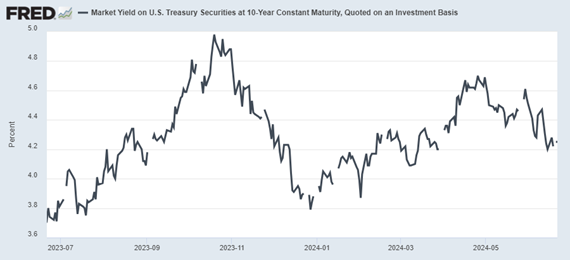The big news last week was that retail sales rose by only 0.1% in May, below the analysts’ consensus estimate of 0.3%. April retail sales were also revised down to a 0.2% decline, from unchanged. Treasury bond yields declined in the wake of this weak retail sales report, since bad news is often good news in the bond market. That could push the Fed to act on interest rates, writes Louis Navellier, founder and chairman of Navellier & Associates.
Excluding gasoline, retail sales rose 0.3% in May. Five of the 13 categories tracked by the Commerce Department contracted in May. Despite this weak retail sales report, the Atlanta Fed kept its second-quarter GDP estimate at 3% (annualized), nearly equal to its previous 3.1% rate.
(Editor’s Note: Louis Navellier is speaking at the 2024 MoneyShow Masters Symposium Las Vegas Aug. 1-3. Click HERE to register)
The bond vigilantes are still in charge of Treasury yields. As I have repeatedly said, the Fed does not fight market rates. So, if the bond vigilantes drive Treasury yields lower, the Fed may be forced to cut key interest rates sooner than they expected. Right now, the consensus is that the Fed will cut key rates on September 18, but I believe that the Fed should cut key interest rates on July 31.
10-Year Treasury Note Yield
Source: Federal Reserve
The Minneapolis district Fed President Neel Kashkari appeared on CBS’s “Face the Nation” last week and said that it’s a “reasonable prediction” that the Fed will wait until December to start cutting key interest rates. Kashkari also said, “We need to see more evidence to convince us that inflation is well on its way back down to 2%,” adding that, “We’re in a very good position right now to take our time, get more inflation data, get more data on the economy and on the labor market, before we make any decisions.”
I should add that Kashkari is a hawkish member of the Fed and does not speak for all FOMC members. Since Kashkari and Chicago Fed President Austan Goolsbee have been very outspoken, it seems that they are undermining Fed Chairman Jerome Powell’s authority, which is just promoting more uncertainty.
The primary catalyst keeping inflation artificially high is shelter costs (“Owners’ Equivalent Rent”) in the Consumer Price Index (CPI) and the Personal Consumption Expenditure (PCE) index. The Wall Street Journal reported last Tuesday that rental costs are still rising in several northeastern and midwestern cities and may continue to complicate the inflation picture.
In the past 12 months, Owners’ Equivalent Rent has risen 5.4%. The proportion of Owners’ Equivalent Rent in the PCE is lower than the CPI, so optimism is rising that the next PCE, to be announced later this month, may indicate that inflation is cooling.
Since our Fed is now lagging Canada and the European Central Bank in cutting key interest rates, “carry trades” are expected to increase. That’s where foreigners put money in the US seeking higher yields in a strong currency. If these carry trades approach a trillion dollars or more, they could continue to drive Treasury yields lower and encourage the Fed to cut key interest rates in July rather than September.





















